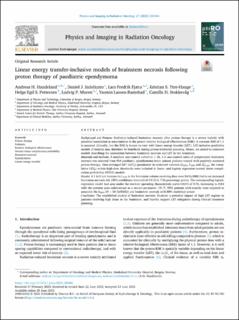| dc.contributor.author | Handeland, Andreas Havsgård | |
| dc.contributor.author | Indelicato, Daniel J. | |
| dc.contributor.author | Fjæra, Lars Fredrik | |
| dc.contributor.author | Ytre-Hauge, Kristian Smeland | |
| dc.contributor.author | Pettersen, Helge Egil Seime | |
| dc.contributor.author | Muren, Ludvig Paul | |
| dc.contributor.author | Lassen-Ramshad, Yasmin | |
| dc.contributor.author | Stokkevåg, Camilla Hanquist | |
| dc.date.accessioned | 2023-08-15T08:24:14Z | |
| dc.date.available | 2023-08-15T08:24:14Z | |
| dc.date.created | 2023-07-27T11:10:53Z | |
| dc.date.issued | 2023 | |
| dc.identifier.issn | 2405-6316 | |
| dc.identifier.uri | https://hdl.handle.net/11250/3084021 | |
| dc.description.abstract | Background and Purpose
Radiation-induced brainstem necrosis after proton therapy is a severe toxicity with potential association to uncertainties in the proton relative biological effectiveness (RBE). A constant RBE of 1.1 is assumed clinically, but the RBE is known to vary with linear energy transfer (LET). LET-inclusive predictive models of toxicity may therefore be beneficial during proton treatment planning. Hence, we aimed to construct models describing the association between brainstem necrosis and LET in the brainstem.
Materials and methods
A matched case-control cohort (n = 28, 1:3 case-control ratio) of symptomatic brainstem necrosis was selected from 954 paediatric ependymoma brain tumour patients treated with passively scattered proton therapy. Dose-averaged LET (LETd) parameters in restricted volumes (L50%, L10% and L0.1cm3, the cumulative LETd) within high-dose thresholds were included in linear- and logistic regression normal tissue complication probability (NTCP) models.
Results
A 1 keV/µm increase in L10% to the brainstem volume receiving dose over 54 Gy(RBE) led to an increased brainstem necrosis risk [95% confidence interval] of 2.5 [0.0, 7.8] percentage points. The corresponding logistic regression model had area under the receiver operating characteristic curve (AUC) of 0.76, increasing to 0.84 with the anterior pons substructure as a second parameter. 19 [7, 350] patients with toxicity were required to associate the L10% (D > 54 Gy(RBE)) and brainstem necrosis with 80% statistical power.
Conclusion
The established models of brainstem necrosis illustrate a potential impact of high LET regions in patients receiving high doses to the brainstem, and thereby support LET mitigation during clinical treatment planning. | en_US |
| dc.language.iso | eng | en_US |
| dc.publisher | Elsevier | en_US |
| dc.rights | Attribution-NonCommercial-NoDerivatives 4.0 Internasjonal | * |
| dc.rights.uri | http://creativecommons.org/licenses/by-nc-nd/4.0/deed.no | * |
| dc.title | Linear energy transfer-inclusive models of brainstem necrosis following proton therapy of paediatric ependymoma | en_US |
| dc.type | Journal article | en_US |
| dc.type | Peer reviewed | en_US |
| dc.description.version | publishedVersion | en_US |
| dc.rights.holder | Copyright 2023 The Author(s) | en_US |
| dc.source.articlenumber | 100466 | en_US |
| cristin.ispublished | true | |
| cristin.fulltext | original | |
| cristin.qualitycode | 1 | |
| dc.identifier.doi | 10.1016/j.phro.2023.100466 | |
| dc.identifier.cristin | 2163754 | |
| dc.source.journal | Physics and imaging in radiation oncology (PIRO) | en_US |
| dc.identifier.citation | Physics and imaging in radiation oncology (PIRO). 2023, 27, 100466. | en_US |
| dc.source.volume | 27 | en_US |

